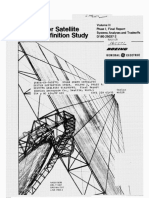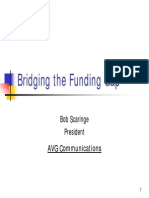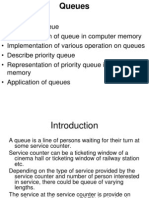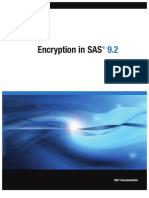0 ratings0% found this document useful (0 votes)
50 viewsIntelligent Satellites
Intelligent Satellites
Uploaded by
Clifford Stone1. The document proposes an architecture for future intelligent Earth observing satellites that can provide data to users quickly, inexpensively and reliably.
2. It envisions a system with multiple layers of satellites, including low Earth orbit satellites collecting data and geostationary satellites facilitating communication. Onboard processing would allow the satellites to work autonomously.
3. The system is designed around user needs, with different users receiving customized data and products through antennas of varying sizes. A control center would manage distribution and guide users.
Copyright:
© All Rights Reserved
Available Formats
Download as PDF, TXT or read online from Scribd
Intelligent Satellites
Intelligent Satellites
Uploaded by
Clifford Stone0 ratings0% found this document useful (0 votes)
50 views11 pages1. The document proposes an architecture for future intelligent Earth observing satellites that can provide data to users quickly, inexpensively and reliably.
2. It envisions a system with multiple layers of satellites, including low Earth orbit satellites collecting data and geostationary satellites facilitating communication. Onboard processing would allow the satellites to work autonomously.
3. The system is designed around user needs, with different users receiving customized data and products through antennas of varying sizes. A control center would manage distribution and guide users.
Copyright
© © All Rights Reserved
Available Formats
PDF, TXT or read online from Scribd
Share this document
Did you find this document useful?
Is this content inappropriate?
1. The document proposes an architecture for future intelligent Earth observing satellites that can provide data to users quickly, inexpensively and reliably.
2. It envisions a system with multiple layers of satellites, including low Earth orbit satellites collecting data and geostationary satellites facilitating communication. Onboard processing would allow the satellites to work autonomously.
3. The system is designed around user needs, with different users receiving customized data and products through antennas of varying sizes. A control center would manage distribution and guide users.
Copyright:
© All Rights Reserved
Available Formats
Download as PDF, TXT or read online from Scribd
Download as pdf or txt
0 ratings0% found this document useful (0 votes)
50 views11 pagesIntelligent Satellites
Intelligent Satellites
Uploaded by
Clifford Stone1. The document proposes an architecture for future intelligent Earth observing satellites that can provide data to users quickly, inexpensively and reliably.
2. It envisions a system with multiple layers of satellites, including low Earth orbit satellites collecting data and geostationary satellites facilitating communication. Onboard processing would allow the satellites to work autonomously.
3. The system is designed around user needs, with different users receiving customized data and products through antennas of varying sizes. A control center would manage distribution and guide users.
Copyright:
© All Rights Reserved
Available Formats
Download as PDF, TXT or read online from Scribd
Download as pdf or txt
You are on page 1of 11
1
Architecture of Future Intelligent Architecture of Future Intelligent
Earth Observing Satellites Earth Observing Satellites
Dr. Guoqing Zhou
October 2001
Old Dominion University
NIAC Fellow Meeting
To get your satellite information at anytime anywhere in
the world
Quickly, Inexpensively, Reliably
Theend-users connect their
(PC) computer to receiver
and antenna for real-time
downlink and display of
satelliteimagery.
It appears to theend-users that receiving thesat-
ellitedatais as easy as selecting a TV channel.
Remote
control
L
O
W
D
a
ta
R
a
te
H
I
G
H
D
a
t
a
R
a
t
e
U
p
l
i
n
k
Geostationary
EOS
D
o
w
n
l
i
n
k
Receiving satellite images is as easily as selecting TV
channel.
I. Why Did We Propose
This Intelligent
System?
The 1
st
Generation: Operational
Reconnaissance
(Early 1960s - 1972)
CORONA, ARGON and LANYARD were the first
three operational imaging satellite reconnaissance
systemlaunched in the early 1960s
3 inch Focus length 322 km Flying Height
Yes (70%) Stereo Panchromatic Band
82.3 Inclination Frame Film Imaging mode
556 x 556 Swath (km) 140 GSD (m)
ARGON 9034A mission, launched on May, 1962, Camera: KH-5
(1972 - 1986)
The 2
nd
Generation: Experimental
Period and Initial Application
TheLandsat 1, launched on August 7, 1972, symbolized the
modern era of earth remote sensing.
Multiple spectral bands
High spatial resolution (80m)
Large area (185kmby 185km)
Repeating coverage (every 18 days)
Satellite image data directly in digital formfor the first time
Much of the foundation of multi spectral data processing in
the early 1970s by NASA, J PL, USGS, ERIM, and LARS
Since 1972, Landsat TM in 1982, 1984 with 30mGSD and 7
spectral bands, until the SPOT HRV in 1986 with 10 mat Pan.
band and 30 mGSD in 3 spectral bands
2
The 3
nd
Generation: Wide Application
and Techni que Further Developed
(1986 1997)
4. Best GSD: 10 min panchromatic
channel, SPOT
5. Active microwave sensor: radar
imagery, ERS-1, ESA, 1991
6. Multimission platform: SPOT,
PFM (PlatformMultimission)
1. Linear array push-broom imaging mode: SPOT
2. Stereo mapping capability: Off-nadir viewing
stereoscopic imagery, SPOT
The 4
th
Generation: High-Resol ution
and Hyperspectral Satellites
In 1995, a conference titled Land Earth Satellite for
Decade sponsored by ASPRS, and co-sponsored by the
Landsat Management Team(NASA, NOAA, and USGS),
NIMA, USDA, EPA, NASA Applications, and others was
held on September 1995 at Tyson's Corner, Virginia.
( 1997 - ? )
More than 700 experts fromsatellite companies, value-
added producers and end user communities to study
anticipated applications, detect potential problems, and
discuss common solutions.
The result of this groundbreaking conference was that
many participants thought that
High-Resolution, Multi(hyper)spectral Satellite
The new generation is
Failed Ikonos-1
Failed QuickBird-1
Failed OrbView-4
10/18/2001 0.61 QuickBird-2 Earth Watch
2003 0.8 EROS B1/B2 USA/Isreal
12/5/2000 1.5 EROS A1 USA/Israel
Late of 2001 5 NEMO USA Navy
End of 2001 1 OrbView-3 ORBIMAGE
9/24/1999 1 Ikonos-2 SpaceImaging
12/24/1997 3 Early Bird Earth Watch
Launch Date Best
GSD (m)
Name Owner
2003 1 IRS-2A
(Cartosat-2)
India
2003 3 CBERS-4 China/Brasil
2002 3 CBERS-3 China/Brasil
2003 2.5 ALOS J apan
2003 3mRadar Radarsat-2 Canada
2001 5 SPOT-5 France
2004 1mRadar TerraSAR Germany
2002 2.5 IRS-P5
(Cartosat-1)
India
Launch
Date
Best GSD
(m)
Name Owner
1960
10
1
1972 1986 1997 2010 Beyond
GSD
(m)
CORONA
Landsat-1
Spot-1
EarlyBird
Future
~13 Year Cycle
12 years 14 years 11 years 13 years
100
Year
History of Earth Observing Satellites
3
II. What Is the NEXT
New Generation of
Earth Observing Satellite
Beyond 2010?!
The Earth observation satellite has passed the
threshold into maturity as a commercial space
activity.
The major features of interest have moved from
Imaging mode
(sensors)
Spatial resolution
Spectral resolution
Spectral coverage
Stereo capability
Revisit capability
Width of swath
Orbital altitude
On-board data
processor
Event-driven data coll.
Multi-angle viewing
High spatial/temporal
resolution
HS land imaging
Multi-sensors/satellites
Valueadded product
TO
Architecture of Future Intelligent Earth
Observing Satellites
Internet
Elements of Future Earth Satellites
Real-time user
Ground center
Antenna
Professional user
Mobile user
Data distribution
Data processing
Professional user
Common user
Space Users Ground
III. Concept Design of
Future Intelligent Earth
Observing Satellites
1. Usually, in space systemdesign, one starts to define and
specify the satellite system.
2. In contrast, the users and their needs formthe starting
point.
Design Principle
4
New societal needs for information, especially mobile GIS
and real-time GIS, have migrated frombasic imagery to
Temporal, dynamic imagery, e.g., flood disaster
Specific site, e.g., World Trade Center disaster site
Update frequently on hourly to minutes basis,
analogous to today's weather updates
Value-added products, e.g., geo-registration, feature
enhancement, radiometric intensification, DTM,
orthophoto, image mosaic, fused MS and Pan scene,
etc.
Users Requirements
A mobile user: e.g., search-and-rescue pilot
in an airplane
A real-time user: e.g. mobile GIS user, a
portable receiver, small antenna and
laptop computer
A common user: e.g., farmer, at a frequency
of 1-3 days
A mineralogist: only hyperspectral imagery
for distinguishing different metals
A cartographic user: e.g.,
photogrammetrist, panchromatic image
Some Examples:
1. Concept Design for the End-User
Elements of End Users
Antenna and Receiver of Intelligent Satellite
Communication between various users and
Ground Control Station
User Software for Intelligent Satellite Data
Processing
Hand-held antenna and receiver for real-time and
mobile users
Mobile antenna for mobile users
Fixed antenna for popular users, professional users or
satellite receiving station
Antenna and Recei ver of Intelligent Satellite:
Principle: Different users will need different imagery,
and different imagery will be assigned different broadcast
frequency.
The ground control station should
Assigns various users with various receiving
frequencies after payment.
Communicate real-time with end-users for guidance
about receiving frequencies, software use, display, etc.
Communication Between Various Users and
Ground Control Station
5
Directly downloaded satellite data satellite imagery
TV antenna receives a signal, not direct picture and
sound. The signal must be transformed by TV set into
picture and sound.
Similarly, the imagery is a type of special signal, which
is only transformed by software which is provided by the
ground control center so that real-time and common users
can easily use it.
User Software for Intelligent Satellite Data
Processing
2. Concept Design of Space Segment
Elements of Space Segment
Multi-layer Satellites Networks
On-Board Data Processing
High-Speed Data Transmission (Crosslink, uplink
and downlink)
Multi-Layer Satellite Network
Earth observing satellites (EOSs) Network
Hundred satellites with a different sensor
Low orbits
Satellite groups, group-lead.
Management of the member-satellites
Communication with other group-leaders
Communication with the geostationarysatellites
Member-satellites
Collection of data
Data processing on-board
Etc.
On-board data processor, act autonomously
Geostationary Satellites Network
Not all EOSsare in view
Communication with end-users
Communication with ground control stations
Further processing of data
Network of An Organic Measurement System
High speed optical and radio frequency links
Archive facilities on the ground and on the satellite
Group-leads (cross-link, uplink, and downlink)
Member satellite (cross-links, uplink)
This systemis specifically designed and built by
support of multiple satellites and sensors
Concept Design for Multi-Sensor/Satellites
current leading commercial
being developed
Future intelligent, e.g., neural
network, smart, etc.
6
All group-lead satellite and EOsmust establish and
maintain a high-speed data cross-link
All group lead satellite maintain uplinkingwith the
geostationarysatellites.
All geostationary satellite must maintain dowlinking
with users and ground data processing center.
High-Speed Data Cross/up/down-links
(Group-lead/EOs Geostationary)
Handheld wireless devices access satellite data for
direct downlink
The intelligent homes monitor their own internal
environments by linking to atmospheric satellite data
The intelligent satellites respond to environmental
changes without human intervention.
Satellite not only "see" users environment, but also
shape users physical surroundings.
High-Speed Data Cross/up/down-links
(Group-lead/EOs Geostationary)
Concept Design for A Type of Imaging
System
Simultaneously collect
pan, MS, and HS (200
bands) data
Push-broom linear array
CCD detectors
Cross-track and in-track
stereo mapping capability
3. Concept Design of Ground
Segment
Elements of Ground Segment
1. System Operation Center (SOC)
Operations center (NOC)
Satellite management center (SMC)
2. Data Processing and Distribution (DPD)
Data Processing and Analysis Center (DPAC)
Data Distribution/Network Operation Center (DDC)
3. End-User
Steers and monitors the
satellite transmissions
continuously
Predicts the satellite ephemeris
Calibrates the satellite flying
parameters and the navigation
message periodically
Evaluates the satellites
performance (health and status)
Take corrective measures
when necessary
System Operation Center (SOC): Control Station
U
p
l
o
a
d
t
h
e
v
a
l
u
e
-
a
d
d
e
d
p
r
o
d
u
c
t
s
7
Communicates with the payload and end-users to
support user access
Establishes network connections
Provides overall network management
Communicates with end-users for problemsolution,
such as receiving frequency, channel, software,
technical guides, etc.
Provides science data filing, notification of
scientists, and data distribution
Network Operation Center (NOC)
IV. Key Technologies
The proposed configuration of FIEOS is technically
feasible. Clearly, information technology and real-time
information systems which tie the satellite-network
together and provide a degree of access to space-based
instrument data currently does NOT exist.
Data collection technologies
High speed digital processors
Optical and RF data links
Network protocols
Storage technologies
Data Collection Technologies
Physical (Electromag.) Sensors: temperature,
atmospheric gases, water vapour, wind, waves, currents,
and land use
Biological Sensors: freshwater, toxic chemicals and
pollutants, both in waters and in soils
Chemical Sensors: atmospheric particles, their size and
chemistry, transport, dispersion and deposition of heavy
metals
Neural Network Sensor: automatic target recognition, If
a sensor saw mostly trees and one small, man-made
structure, the pixel showed only trees
The Eyes in Space
On-Board Data Processing Capabilities
Data processor technology
Image (signal) processor technology
Software systems and algorithms
High performance processing architectures
Reconfigurablecomputing environments
Generation of data products for direct distribution to
users
One of the essential capabilities provided by on board
processing is autonomy
1. Platforms controlled intelligently and autonomously
2. Platforms adjust their positions in space relative to
the constellation of sensors in response to
collaborative data gathering
3. To operate autonomously single satellite and
satellite-web
4. Decision support, planning
5. High level command protocols based on science
objectives.
Intelligent Platform Control
8
Network for High Data Rate Transmission
A high speed wireless (optical or RF) data linking to
connect satellite to satellite, or satellite to ground is
required.
The Weakest Links: the free space wireless cross-link of
satellites and between satellite and ground.
The Greatest Challenge: establishment and maintenance
of a viable communication network among a constellation
of satellites operating in diverse orbits.
This is NOT a simple problem due to the relative
velocities of the component satellites in the constellation.
Data Storage and Distribution
Many advanced and novel technologies
Data mining
Intelligent agent applications for tracking data,
distributed heterogeneous frameworks
(including open system interfaces and
protocols)
Data and/or metadata structures to support
autonomous data handling
Value-Added Data Production
In order to make the value-added data products useful to a
common user,
Application software
Application algorithms
Dynamic searching
Dynamic collection and cataloging
Computational Speed of Dynamic Interaction !!!!!
Problems:
Prerequisite Condition of Direct
Downlink
DEM
database
Geo-data database Imagery database
Attribute
database
Spatial
database
P
o
i
n
t
C
o
m
p
l
e
x
A
n
n
o
t
a
t
i
o
n
A
r
e
a
L
i
n
e
Unique
identifier
On-board
image processing
Satellite
images
Ortho mapimage
DEM database
Integrated Management System
Integrated On-board Management
System (Image, DEM and Geo-data)
V. Current Development
9
Automated, on-board processing,
analysis, and feature extraction
using the Naval Research
Laboratory's (NRL's) Optical
Real-Time Adaptive Signature
Identification System (ORASIS)
Naval EarthMap Observer (NEMO)
Realtimefeature extraction and classification
with greater than 10x data reduction
High-performance Imagery On-Board
Processor provides greater than 2.5
gigaFLOPSof sustained computational power
On-board data storage (56 gigabit)
Military Application: Real-time tactical downlink of
hyperspectral and products directly to the field for
warfighter
High data rate X-Band
Downlink (150 Mbps)
Low data rate S-Band
Tactical Downlink (1 Mbps)
Commercial satellite bus
(Space Systems Loral LS-
400)
PreconfiguredInterface
(PCI) for secondary
payloads/experiments
NEMO
On-Board Data Processing Capabilities
A thematic on-boardclassificator
for disaster warning and
monitoring
Radiometric and geometric on-
board correction of sensor signals
Geometric on-board correction of
systematic alignment errors
Geometric on-board correction of
spacecraft attitude
On-board geocodingof
thematically processed data
DLR BIRD Mission (Fire Monitoring)
Real-time Downlink
Immediate
downlink of
regional data
Downlink of an
alert message if
required
Store-and-forward,
data downlink to
low-cost payload
ground stations
Probais an ESA mission conceived
for the purpose of demonstrating
new on board technologies and the
opportunities and benefits of on-
board autonomy.
GPS receiver
Autonomous star tracker
A high-performance computer
A Digital Signal Processor for on-
board data processing and analysis
A mass memory
PROBA: ESA's Autonomy And Technology
Demonstration Mission
MISSION OPERATIONS CONCEPT of
PROBA
On-board housekeeping
decision-making process, i.e. failure detection,
failure identification and first-level recovery actions.
On-board data management:
data handling, storage, and downlinks (a 1Gbit
mass memory for recording, atuneable2Kbit/s to 1
Mbit/s down-link).
10
On-board resources usage
power and energy usages
On-board instrument commanding
Planning, scheduling, resource management,
navigation, and instrument pointing
Downlinks of the processed data
On-board science data distribution
Automatic direct data distribution to different user
without human involvement
Minimumpossible delay
MISSION OPERATIONS CONCEPT of
PROBA
COCONUDS (Co-ordinated Constellation of
User Defined Satellites)
The objective is to ascertain the practicality of a radically
different, low-cost, distributed network approach to satellite
earth observation.
Co-ordinatedconstellation of 10 polar orbiting micro-
satellites
Generating low-bitratecontinuous data stream
without on-board storage
Four-band imagers, with 33 mresolution, and swath
width of 350 km
Distributed and free user
community
Ground stations are operated by
end-users
Minimumstation configuration
(3.5 Mbps)
Higher performance stations
(typical 100 Mbps)
Area of interest from2000 km
radius with 2.5 mtracking dish to
400 x 400 kmwith fixed antenna
For some point & shoot sensors
users may uplink pointing requests
European Union
(Geosys, NRI, SSSL,
and NLR)
VI. Financial, Political,
Social and Institutional
Issues
Reall y big bucks, literall y billi ons, are required
Investment fromusers, public and private sector
Government agencies always
have the highest priority
In fact, some of government
agencies are partially on the
path toward construction
VII. Conclusion
11
The design of future earth observing satellites
Space segment
End-users segment
Ground segment.
On-board processing
Intelligent sensor control
High data rate transmission and network control
Intelligent platformcontrol
Information production, distribution and storage
Focus on
The key to this vision: Real-Time Info. System
To raise awareness as to
Needs
Possibilities
Benefits
Issues
Funding
Goal
Future
1. Further assess key issues for such a advanced
system
2. Raise awareness concerning:
autonomy domains and requirements for future
space missions
currently available mature technology
verification and validation techniques for such
a system
current state of the art and (in-flight) autonomy
demonstrations in Europe and the United states
3. Stimulate co-operation between the Space
and Research Communities and small
businesses to solve critical problems of
fielding advanced concepts in space
ACKNOWLEDGEMENTS
This project is funded by NASA Institute of
Advanced Concept (NIAC). Our warmest
thanks go to all the people who were kind
enough to lend us their ears (or mail) to discuss
a number of topics crucial for completion of
our work.
For More Information
gzhou@odu.edu
You might also like
- Onboard Data Handling and Telemetry: Lesson 2: The Complete Cdhs ArchitectureDocument42 pagesOnboard Data Handling and Telemetry: Lesson 2: The Complete Cdhs ArchitectureDavid Diaz RivasNo ratings yet
- MEM Gyros For Space ApplicationsDocument12 pagesMEM Gyros For Space ApplicationsHongraekim100% (1)
- Chrome Group PolicyDocument37 pagesChrome Group PolicyvksatyanNo ratings yet
- Chrome FlagsDocument12 pagesChrome Flagsmeraj1210% (1)
- InfoPath TutorialDocument4 pagesInfoPath Tutorialrupeshtarwade100% (1)
- Nature-Inspired Design of Hybrid Intelligent SystemsDocument817 pagesNature-Inspired Design of Hybrid Intelligent SystemsJan100% (1)
- ITIL - Knowledge ManagementDocument14 pagesITIL - Knowledge ManagementFederico MarzulloNo ratings yet
- China N Second Space Age 1003Document12 pagesChina N Second Space Age 1003Alejandro Kanito Alvarez SNo ratings yet
- ISS Rendezvous, Proximity Operations, Docking & Berthing ConsiderationsDocument39 pagesISS Rendezvous, Proximity Operations, Docking & Berthing ConsiderationsCamilo Andres ReyesNo ratings yet
- HL-10 First Rocket FlightDocument4 pagesHL-10 First Rocket FlightBob AndrepontNo ratings yet
- Spacex BrochureDocument7 pagesSpacex BrochureLuigiNo ratings yet
- On-Orbit Servicing: HermesDocument39 pagesOn-Orbit Servicing: HermesCharis KosmasNo ratings yet
- 20 Picosats 9Document21 pages20 Picosats 9Ahmed El ShafieNo ratings yet
- A Sustained Lunar Presence NSPC Report4220finalDocument13 pagesA Sustained Lunar Presence NSPC Report4220finalDavid YorkNo ratings yet
- Go Taikonauts - Issue 12Document46 pagesGo Taikonauts - Issue 12Junior MirandaNo ratings yet
- NASA 120272main FS-015-DFRCDocument6 pagesNASA 120272main FS-015-DFRCNASAdocumentsNo ratings yet
- Annex1 ESA ISS CC AO Climate ChangeDocument71 pagesAnnex1 ESA ISS CC AO Climate ChangePedro LeonNo ratings yet
- The Aircraft Simulation Role in Improving Flight Safety ThroDocument21 pagesThe Aircraft Simulation Role in Improving Flight Safety ThroWylliam Diel WagnerNo ratings yet
- Space TechnologyDocument46 pagesSpace Technologyrane.salomonNo ratings yet
- Interim Research Proposal On The Removal of Space Debris Using Robot ManipulatorsDocument13 pagesInterim Research Proposal On The Removal of Space Debris Using Robot ManipulatorsHans LalNo ratings yet
- Antisatellite Weapons: Guide:Lt CDR Chetanlal DetheDocument22 pagesAntisatellite Weapons: Guide:Lt CDR Chetanlal DetheRavi ShankarNo ratings yet
- Docking System Mechanism Utilized On Orbital Express ProgramDocument14 pagesDocking System Mechanism Utilized On Orbital Express ProgramavenashaNo ratings yet
- Space StationsDocument19 pagesSpace StationsConnochaetesTaurinusNo ratings yet
- Apollo MissionsDocument14 pagesApollo Missionsleo simporiosNo ratings yet
- 639595main EA Test Facilities GuideDocument66 pages639595main EA Test Facilities GuideMEYWALKERNo ratings yet
- Seventh Semiannual Report To CongressDocument170 pagesSeventh Semiannual Report To CongressBob Andrepont100% (1)
- 187709main NASA Research and Utilization Plan For The ISS PDFDocument94 pages187709main NASA Research and Utilization Plan For The ISS PDFSayanNo ratings yet
- Lecture 02 HardwareDocument167 pagesLecture 02 HardwareNguyễn Tấn ĐịnhNo ratings yet
- Instruments Used To Observe The Universe TheoriesDocument45 pagesInstruments Used To Observe The Universe TheoriesROWENANo ratings yet
- Developing National Power in Space - A Theoretical Model (PDFDrive)Document499 pagesDeveloping National Power in Space - A Theoretical Model (PDFDrive)NunoVinhaNo ratings yet
- Leon GuideDocument31 pagesLeon GuidejagruthimsNo ratings yet
- Solar MicroWv FabricDocument37 pagesSolar MicroWv FabricShawn Paul BoikeNo ratings yet
- USCC China Space Program Report-April 2012Document85 pagesUSCC China Space Program Report-April 2012Jonathan WestonNo ratings yet
- Cubesat Deformable Mirror Demonstration: CitationDocument12 pagesCubesat Deformable Mirror Demonstration: CitationjonNo ratings yet
- Lunar Missions - OdakkalDocument53 pagesLunar Missions - Odakkalgeronimostilton1988No ratings yet
- Cisc vs. RiscDocument53 pagesCisc vs. RiscnikitaNo ratings yet
- Remote Attacks On FPGADocument188 pagesRemote Attacks On FPGAMiriam Casado RodríguezNo ratings yet
- 1130 Using Robots For AdvancedDocument27 pages1130 Using Robots For AdvancedAnderson BrazilNo ratings yet
- NAV 3 Electronic Navigation and Compasses Part 1Document225 pagesNAV 3 Electronic Navigation and Compasses Part 1Mika MedinaNo ratings yet
- Bul124b MccoyDocument6 pagesBul124b MccoydnanaNo ratings yet
- Space Policy-Space Principles of War-UnclassifiedDocument15 pagesSpace Policy-Space Principles of War-UnclassifiedSpaceStrategosNo ratings yet
- A Complete Survey On Onborad Computers Microcontroller Selection For Icube2 CUBESATDocument5 pagesA Complete Survey On Onborad Computers Microcontroller Selection For Icube2 CUBESATZammad AhmadNo ratings yet
- Lunar Resources: Jump To Navigationjump To SearchDocument10 pagesLunar Resources: Jump To Navigationjump To SearchAryan KhannaNo ratings yet
- KSP Tutorial IndexDocument5 pagesKSP Tutorial IndexMircea HalipNo ratings yet
- 2013 11 04 Satellite Engineering THER LJ PDFDocument121 pages2013 11 04 Satellite Engineering THER LJ PDFishworNo ratings yet
- Satellite NotesDocument101 pagesSatellite NotesRohan Sharma 20EC24No ratings yet
- EmbeddedSystemDesignECM IA1Document200 pagesEmbeddedSystemDesignECM IA1jvgirish74No ratings yet
- 1A First MeetingDocument42 pages1A First MeetinglricccNo ratings yet
- Spacecraft AssignmentDocument11 pagesSpacecraft AssignmentMuhammad Khurram KhalilNo ratings yet
- SoyuzDocument7 pagesSoyuzviveknarayanNo ratings yet
- Solar Sails - A Future in SpaceDocument62 pagesSolar Sails - A Future in SpaceManishTripathi1189No ratings yet
- Solar Power Satellite System Definition Study - NASADocument547 pagesSolar Power Satellite System Definition Study - NASAChristian MarquezNo ratings yet
- Robotic Lunar Exploration Scenario JAXA PlanDocument26 pagesRobotic Lunar Exploration Scenario JAXA PlanPedro LeonNo ratings yet
- Electric PropulsionDocument58 pagesElectric PropulsionRishikesh DineshNo ratings yet
- Insat3d CatalogDocument99 pagesInsat3d Catalogmanish_paliwalNo ratings yet
- JWST Science Pub v1 2Document99 pagesJWST Science Pub v1 2Luis Contreras SedesNo ratings yet
- NASA: 182928main Transcript-Grumman Engineers 072007Document51 pagesNASA: 182928main Transcript-Grumman Engineers 072007NASAdocumentsNo ratings yet
- Chapter3 - Space Environment & Its EffectsDocument41 pagesChapter3 - Space Environment & Its EffectsTânNo ratings yet
- Eee 545:satellite Communications: Danson NjueDocument28 pagesEee 545:satellite Communications: Danson NjueMtende MosesNo ratings yet
- Gemini Sumary ConferenceDocument349 pagesGemini Sumary Conferencesonofkrrypton100% (2)
- SpacePower-Starlink 4 Elon 2024 MemDayDocument95 pagesSpacePower-Starlink 4 Elon 2024 MemDayShawn Paul BoikeNo ratings yet
- Nanosatellite Swarm Missions in Low Earth Orbit Using Laser PropulsionDocument9 pagesNanosatellite Swarm Missions in Low Earth Orbit Using Laser PropulsionRatnendra SinghNo ratings yet
- A Much Unsung Hero, The Lunar Landing Training Vehicle: And Other NASA RecollectionsFrom EverandA Much Unsung Hero, The Lunar Landing Training Vehicle: And Other NASA RecollectionsRating: 5 out of 5 stars5/5 (1)
- Global Constellation of Stratospheric Scientific PlatformsDocument49 pagesGlobal Constellation of Stratospheric Scientific PlatformsClifford StoneNo ratings yet
- Shield PDFDocument26 pagesShield PDFClifford StoneNo ratings yet
- Somali 1 PDFDocument3 pagesSomali 1 PDFClifford StoneNo ratings yet
- Smith Memo Nov., 21, 1950 PDFDocument3 pagesSmith Memo Nov., 21, 1950 PDFClifford StoneNo ratings yet
- An Architecture For Self-Replicating Lunar FactoriesDocument28 pagesAn Architecture For Self-Replicating Lunar FactoriesClifford StoneNo ratings yet
- Wind Driven Power Generation On Titan Windmills - : in Space!Document16 pagesWind Driven Power Generation On Titan Windmills - : in Space!Clifford StoneNo ratings yet
- Propagating Magnetic Wave Accelerator (PMWAC) For Manned Deep Space MissionsDocument19 pagesPropagating Magnetic Wave Accelerator (PMWAC) For Manned Deep Space MissionsClifford StoneNo ratings yet
- Autonomous Self-Extending Machines For Accelerating Space ExplorationDocument25 pagesAutonomous Self-Extending Machines For Accelerating Space ExplorationClifford StoneNo ratings yet
- Bridging The Funding Gap: Bob Scaringe PresidentDocument8 pagesBridging The Funding Gap: Bob Scaringe PresidentClifford StoneNo ratings yet
- SearchForLifeOnEuropa PDFDocument16 pagesSearchForLifeOnEuropa PDFClifford StoneNo ratings yet
- Sailbeam: Space Propulsion by Macroscopic Sail-Type ProjectilesDocument34 pagesSailbeam: Space Propulsion by Macroscopic Sail-Type ProjectilesClifford StoneNo ratings yet
- Roswell PDFDocument993 pagesRoswell PDFClifford Stone100% (1)
- Gonatual (Comp.)Document22 pagesGonatual (Comp.)gener v. valdesNo ratings yet
- Sec 14Document12 pagesSec 14Bruno AlvesNo ratings yet
- Dolby Media Meter 2 User's ManualDocument28 pagesDolby Media Meter 2 User's ManualAznboy1993No ratings yet
- Downloading Connector/Net: Insert Update Select DeleteDocument13 pagesDownloading Connector/Net: Insert Update Select DeleteRos KamalNo ratings yet
- Factor AnalysisDocument11 pagesFactor AnalysisGeetika VermaNo ratings yet
- Driver TV Tuner Gadmei 3810eDocument2 pagesDriver TV Tuner Gadmei 3810eAl-Shahibul RahmanMSSNo ratings yet
- American Sign Language Translation Through Sensory GloveDocument14 pagesAmerican Sign Language Translation Through Sensory GloveShah RukhNo ratings yet
- CS 236501 Introduction To AI: Tutorial 8 ResolutionDocument20 pagesCS 236501 Introduction To AI: Tutorial 8 ResolutionGomathi ShanmugamNo ratings yet
- Nazeer Amjad Ahamed CVDocument3 pagesNazeer Amjad Ahamed CVLeslie BakerNo ratings yet
- CPSC 352 - Artificial Intelligence Notes: A Algorithm Admissibility, Monotonicity, InformednessDocument4 pagesCPSC 352 - Artificial Intelligence Notes: A Algorithm Admissibility, Monotonicity, InformednessshuvasalvaNo ratings yet
- MPMC University Question Papaers PDFDocument15 pagesMPMC University Question Papaers PDFRajasekar PichaimuthuNo ratings yet
- Queues in Data Structure Using CDocument52 pagesQueues in Data Structure Using CKaran RoyNo ratings yet
- SOA - Introduction: Srikanth GunturuDocument20 pagesSOA - Introduction: Srikanth GunturusrikanthgsNo ratings yet
- Opening A RestaurantDocument29 pagesOpening A RestaurantDavinder SinghNo ratings yet
- Installing Vio ServerDocument8 pagesInstalling Vio Servers_mullickNo ratings yet
- Br100 SCM Om Global Setup Document v1Document83 pagesBr100 SCM Om Global Setup Document v1cmrsman01No ratings yet
- The Complete ChaRM Solution (Change Request Management)Document11 pagesThe Complete ChaRM Solution (Change Request Management)abdulgani111No ratings yet
- Encryption in SAS 9.2Document84 pagesEncryption in SAS 9.2Puli SreenivasuluNo ratings yet
- Narayan MurthyDocument12 pagesNarayan MurthySumit RajdharNo ratings yet
- VLSI Placement Parameter Optimization Using Deep Reinforcement LearningDocument9 pagesVLSI Placement Parameter Optimization Using Deep Reinforcement LearningNelarapuMaheshNo ratings yet
- High Speed DATA-Optimize: The Future of High Speed Machining Has Arrived .Document4 pagesHigh Speed DATA-Optimize: The Future of High Speed Machining Has Arrived .Poghos PetrosNo ratings yet
- Always Encrypted PDFDocument21 pagesAlways Encrypted PDFrajiv_ndpt8394No ratings yet
- Stucor Qp-Ec8791Document5 pagesStucor Qp-Ec8791NGSNo ratings yet
- Maui Remote Control and Automation ManualDocument402 pagesMaui Remote Control and Automation ManualLalit DaniNo ratings yet
- Product Costing - Cost Estimation in SAPDocument12 pagesProduct Costing - Cost Estimation in SAPlakhbir67% (6)





































































































